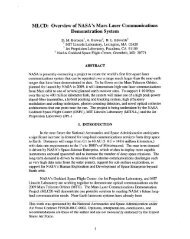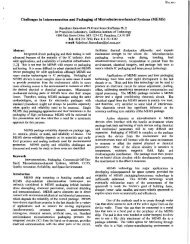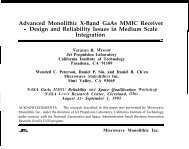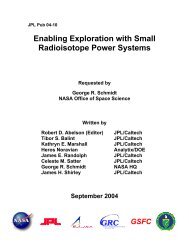Unmanned ground vehicle perception using thermal infrared cameras
Unmanned ground vehicle perception using thermal infrared cameras
Unmanned ground vehicle perception using thermal infrared cameras
You also want an ePaper? Increase the reach of your titles
YUMPU automatically turns print PDFs into web optimized ePapers that Google loves.
<strong>Unmanned</strong> <strong>ground</strong> <strong>vehicle</strong> <strong>perception</strong> <strong>using</strong><br />
<strong>thermal</strong> <strong>infrared</strong> <strong>cameras</strong><br />
Arturo Rankin, Andres Huertas, Larry Matthies, Max Bajracharya,<br />
Christopher Assad, Shane Brennan, and Paolo Bellutta<br />
Jet Propulsion Laboratory, California Institute of Technology<br />
Gary Sherwin<br />
General Dynamics Robotic Systems (GDRS)<br />
This research was carried out by the Jet Propulsion Laboratory,<br />
California Institute of Technology, under the Robotics Collaborative<br />
Technology Alliances program, through an agreement with NASA.<br />
Copyright 2011 California Institute of Technology. Government sponsorship acknowledged.<br />
1
Topics Addressed<br />
• TIR <strong>cameras</strong> used by JPL/GDRS for UGV programs<br />
• Calibrating TIR stereo <strong>cameras</strong><br />
• Dense stereo ranging with TIR <strong>cameras</strong><br />
• Terrain classification<br />
– Soil vs. vegetation<br />
• Obstacle detection<br />
– pedestrians, <strong>vehicle</strong>s, negative obstacles, water bodies<br />
• Perception thru obscurants<br />
• Summary<br />
2
Program<br />
Year<br />
Camera<br />
Specs of Sample TIR Cameras<br />
Demo III<br />
2001<br />
Cooled Merlin<br />
MWIR<br />
PerceptOR<br />
2002<br />
Cooled NC256<br />
MWIR<br />
PerceptOR<br />
2002<br />
Uncooled<br />
Alpha LWIR<br />
RCTA<br />
2011<br />
Uncooled<br />
Photon LWIR<br />
Power (W) 30 16 1.5
Color<br />
image<br />
Thermal<br />
<strong>infrared</strong><br />
image<br />
Calibrating TIR Stereo Cameras<br />
2000, JPL-Demo3<br />
Lab fixture with<br />
plastic inserts heated<br />
by light bulbs<br />
Heating not uniform<br />
2002, JPL-PerceptOR<br />
Dot pattern on portable<br />
foam core board heated<br />
by the sun<br />
Not usable on<br />
overcast day<br />
2010, GDRS-RCTA<br />
Grid of fine wires aligned<br />
with transition lines heated<br />
by current flow<br />
4
GDRS Multispectral / Multimodal<br />
Calibration Target<br />
• Pattern aligned, laminated SWIR / LWIR-lighting wires provide<br />
commonly located square corners<br />
• Reverse-side printed pattern presents consistent matte material (<br />
lexan® ) surface<br />
• Rigid aluminum honeycomb support panel presents metallic surface<br />
for RADAR & SONAR<br />
LWIR View<br />
Overlaid on<br />
Visible View<br />
5
Dense Stereo Ranging<br />
• Real-time stereo algorithms work with color and TIR <strong>cameras</strong><br />
• Issues that affect the quality of TIR dense stereo range data<br />
– Image blur<br />
– Scenes with low texture<br />
– Poor calibration<br />
Example stereo range images from stationary UGV, 3pm<br />
Thermoteknix Miricle 110KS LWIR <strong>cameras</strong><br />
384x288 pixels, 31cm baseline, 7ms time constant<br />
6
Image Blur<br />
• Image blur occurs when there is too much<br />
motion during the exposure time<br />
• Since uncooled LWIR <strong>cameras</strong> have long<br />
exposure times, they are susceptible to<br />
image blur<br />
P<br />
General camera motion<br />
Image blur equation<br />
1 v forward Texp<br />
sin<br />
vup<br />
Texp<br />
cos<br />
<br />
<br />
<br />
tan <br />
T<br />
<br />
R vforward Texp<br />
cos<br />
vup<br />
Texp<br />
sin<br />
<br />
<br />
<br />
IVFOV<br />
exp<br />
Image blur due to high UGV<br />
pitch rate on rough terrain<br />
Frame N Frame N+1<br />
Image blur as a function of<br />
UGV speed on flat terrain<br />
(Assumptions: IVFOV=2.24mrad,<br />
H=1.53m, 5° down tilt)<br />
7
Image Blur Effect on Stereo<br />
• A UGV was manually driven over a dirt trail at several different speeds<br />
at ~3pm on a sunny day<br />
• Minor loss in stereo range data with increasing speed<br />
4m/s 6m/s 8m/s<br />
8
Image Blur Effect on Stereo<br />
9
Low Texture Effect on Stereo<br />
• Poor stereo correlation due to low texture can occur with cooled and<br />
uncooled TIR <strong>cameras</strong><br />
• Performing AGC on a region of interest that excludes the sky can<br />
improve stereo data density<br />
Miricle 110KS Uncooled LWIR:<br />
Portion of dirt trail with low texture<br />
AGC performed over the entire image<br />
(from 12 m/s sequence)<br />
Merlin Cooled MWIR:<br />
Blacktop surface heated by the sun<br />
AGC performed over the lower ¾ of the image<br />
(from 12 m/s sequence) 10
Scene from<br />
Chatfield State<br />
Park, CO<br />
Mahalanobis<br />
distance<br />
classifier, 4<br />
nightime<br />
periods<br />
independently<br />
trained.<br />
Dual Band Terrain Classification<br />
8:00pm<br />
10:40pm<br />
3:40am<br />
5:40am<br />
MWIR<br />
images<br />
Cropped/<br />
warped<br />
LWIR<br />
images<br />
2D<br />
histogram<br />
(MWIR<br />
vs.<br />
LWIR)<br />
6 class<br />
result<br />
11
Stereo pair of<br />
rectified images<br />
from Ft. Polk<br />
Traversability<br />
red: severe hazard<br />
yellow: moderate hazard<br />
Tree Trunk Detector<br />
Edge detection Extracted contours<br />
with matched polarity<br />
Range image<br />
Tree diameter image<br />
(darker=thinner)<br />
Range data within<br />
tree trunks<br />
Raw fragments<br />
Ellipse fit<br />
Tree trunk<br />
segments<br />
12
Rectified intensity<br />
image<br />
Final result<br />
Negative Obstacle Detection<br />
LoG image (σ=1.75)<br />
Perform geometry<br />
based filtering<br />
Pixels w/ negative<br />
values < -1.8<br />
Candidate negative<br />
obstacles<br />
Closed contours after<br />
small blob removal<br />
Normalized intensity<br />
difference image<br />
Ditch warmer than surround @ night. First detection at 18m (3 pixels wide)<br />
13
Left rectified frame N<br />
Left rectified image<br />
Range<br />
image<br />
Polar<br />
perspective<br />
map<br />
Pedestrian Detection<br />
Cartesian<br />
map<br />
Left rectified frame N+4<br />
• Approach<br />
– Generate dense stereo range<br />
data<br />
– Perform visual odometry to<br />
compute the change in pose of<br />
the UGV<br />
– Detect and segment regions of<br />
interest in the 3D stereo point<br />
cloud which have a width and<br />
height consistent with an<br />
upright human<br />
– Classify each region of interest<br />
with a probability of being<br />
human<br />
– Track the regions of interest<br />
over multiple frames.<br />
14
Vehicle Detection<br />
• Initially implemented to improve the detectability of partially<br />
occluded pedestrians, and reduce pedestrian false alarms<br />
• Stage 1: large blobs in stereo range point cloud are extracted and<br />
assigned a feature vector<br />
• Stage 2: feature vector of each extracted blob is passed to a linear<br />
classifier which determines whether or not the blob is a <strong>vehicle</strong>.<br />
Color image LWIR image<br />
Candidate <strong>vehicle</strong> blob<br />
Ground truth <strong>vehicle</strong><br />
True positive classification<br />
LWIR Stereo range image<br />
15
02:00<br />
Water Detection<br />
• A 24 hour MWIR data collection was performed on a water body<br />
• The water body was warmer than other terrain types from 2-5am<br />
02:00<br />
15:40<br />
16
02:00<br />
15:00<br />
Water Detection<br />
• Cues for water from TIR intensity images and stereo<br />
Water in cluttered area:<br />
Reflections of objects in<br />
the back<strong>ground</strong><br />
Left rectified image<br />
Far water in open area:<br />
Intensity similar to the sky<br />
Stereo range image<br />
Close water in open area:<br />
Intensity increases with<br />
increasing incidence<br />
100m map<br />
17
Perception thru Obscurants<br />
• Detect emitted energy through fog, dust, rain, snow, and<br />
some types of smoke<br />
Fog oil<br />
smoke<br />
HC<br />
smoke<br />
Visible image Visible stereo range MWIR image with MWIR stereo range<br />
truck at 40m<br />
Visible image Visible stereo range<br />
MWIR image of<br />
forest<br />
MWIR stereo range<br />
18
Fog<br />
Smoke<br />
from a<br />
controlled<br />
burn<br />
Perception thru Obscurants<br />
Color camera<br />
Photon 640 LWIR camera<br />
19
Summary<br />
• TIR <strong>cameras</strong> can be used for day/night UGV autonomous<br />
navigation when stealth is required<br />
• The quality of uncooled TIR <strong>cameras</strong> has significantly<br />
improved over the last decade, making them a viable<br />
option at low speed<br />
• Limiting factors for stereo ranging with uncooled LWIR<br />
<strong>cameras</strong> are image blur and low texture scenes<br />
• TIR <strong>perception</strong> capabilities JPL has explored includes:<br />
– single and dual band TIR terrain classification<br />
– obstacle detection (pedestrian, <strong>vehicle</strong>, tree trunks, ditches,<br />
and water)<br />
– <strong>perception</strong> thru obscurants<br />
20
Questions?<br />
21



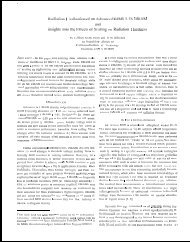


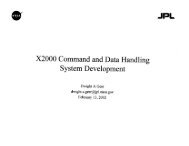
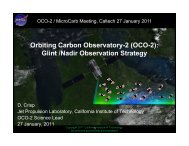

![Ana]ysis of Reaction Products and Conversion Time in the Pyrolysis ...](https://img.yumpu.com/11715548/1/190x242/anaysis-of-reaction-products-and-conversion-time-in-the-pyrolysis-.jpg?quality=85)
